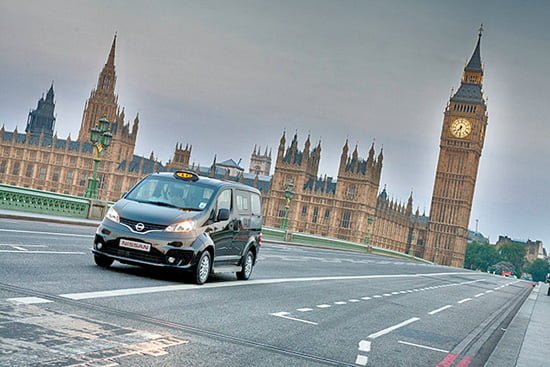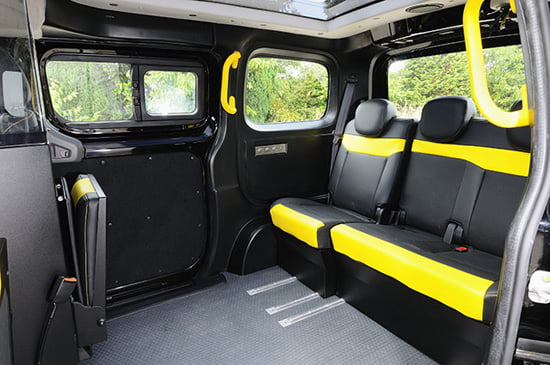
Nissan Taxi Westminster Bridge
Nissan has shown off the design for its new black cab, which should begin crawling round the capital's streets from next year.
The Nissan NV200 will serve as an alternative to the current vehicles, principally the TX4, manufactured by the London Taxi Company. Drivers might be tempted by the Japanese diesel vehicle's superior miles per gallon and lower price point (at around £28,000, it will be £4,000 cheaper than the TX4), while Nissan boasts that their model will help cut carbon dioxide emissions in half.
The taxi sports twin sliding doors, a wheelchair ramp and a glazed roof, through which passengers will be able to observe London's leaden skies. Nissan also hopes to release an electric version of the taxi in 2014; Boris Johnson has previously promised that all London taxis will be electric by 2020. Autocar has more on thetechnical specifications.
Design-wise, the new taxi is disappointing: it's basically a nondescript van with the distinctive orange lamp affixed front and centre. Something about it must appeal to municipal leaders, though — last year Nissan won the licence to supply all of New York's yellow taxis using a similar model.
Here's a video of the taxi in action: [iframe width=”550″ height=”309″ src=”http://www.youtube.com/embed/WOAJ6sRSL9w?rel=0″ frameborder=”0″ allowfullscreen]
Cheaper to buy and run, diesel NV200 model is 50% more fuel & CO2 efficient than most efficient current London cabs
- Huge reductions in most harmful NOx and PM emissions
- Fully electric version planned for 2014
- Fully backed by London Mayor, Boris Johnson, the London Taxi Drivers' Association, TfL, the GLA and disability groups
- Designed for greater safety, comfort, space, convenience and accessibility
- Performs vital 25ft turning circle
Nissan today REVEALS a new vision for the future of the London ‘black cab' and its 300,000 daily users — the Nissan NV200 London Taxi.
Already unveiled as an official new cab for Tokyo and the exclusive New York City ‘Taxi of Tomorrow‘, the new cab will pick up their first fares on London's streets in Spring 2014.
Currently there are only two alternatives for London's 22,600 cab drivers, the traditional ‘LTI TX4 and the Mercedes Vito.
The NV200 will generate 50% less CO2 than the best current taxi model (139g/km vs 209g/km) — in line with Mayor Boris Johnson's Air Quality Strategy for London.
Even more importantly the harmful NOx (nitrogen oxide) and PM (particulate) gases will reduce significantly in line with TfL's and GLA's targets. NOx emissions will come down from 0.50g/km to 0.14g/km, important when 10% of Greater London's NOx emissions come from black cabs, while PM emissions, which account for 20% of central London‘s airborne pollution, will come down from 0.056g/km to 0.001g/km.
The NV200 will also be 50% more fuel efficient than the best current alternative, its 1.5 litre engine achieving 53.3 mpg (miles per gallon) versus 35.3mpg. The average London cab travels 120 miles a day, so it will see cabbies save almost £700 a year.
The NV200 will also be priced very competitively and significantly below the current equivalent, the London Taxi Company's new TX4 model.
It will comfortably seat five adults — three on a rear bench with two on rear-facing, fold-down seats. All will be able to admire the London skyline through the 1.2m2 transparent roof. Its sliding doors are much safer for pedestrians, cyclists and other vehicles because they do not swing out to create a potential obstruction.
The eNV200 – London's first electric taxi – is expected to hit London's streets in 2014 too. With running costs estimated to be around one fifth of a conventional, diesel-powered Hackney Carriage, its launch will arrive six years ahead of the Mayor's target of 2020 for the introduction of a zero emissions taxi.
Nissan already has a respected place in the Capital's taxi history — its 2.7-litre TD27 diesel engine was chosen for the iconic FX4 Fairway black cab in 1989, which introduced improved speed, reliability and efficiency to the London cabbie's daily drive. The same engine also featured in the Fairway's successor, the TX1.





Comments